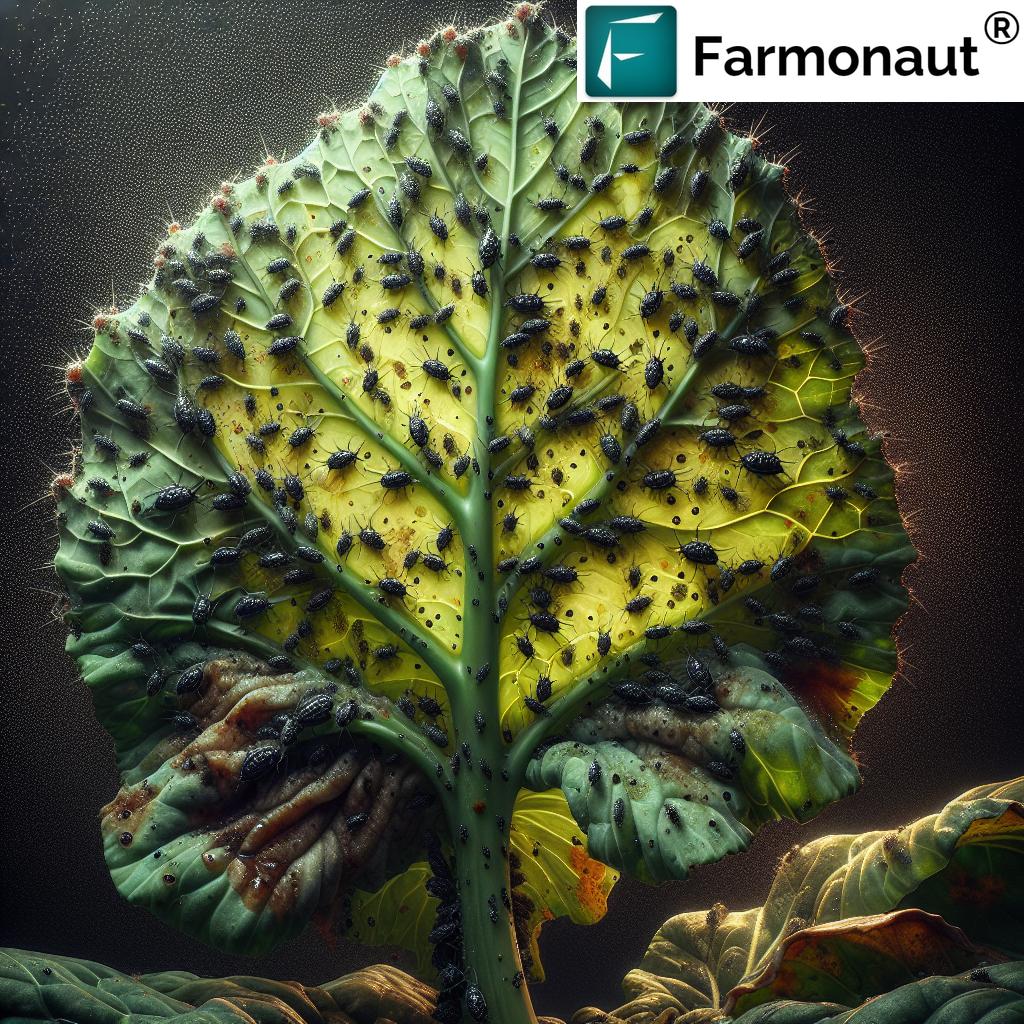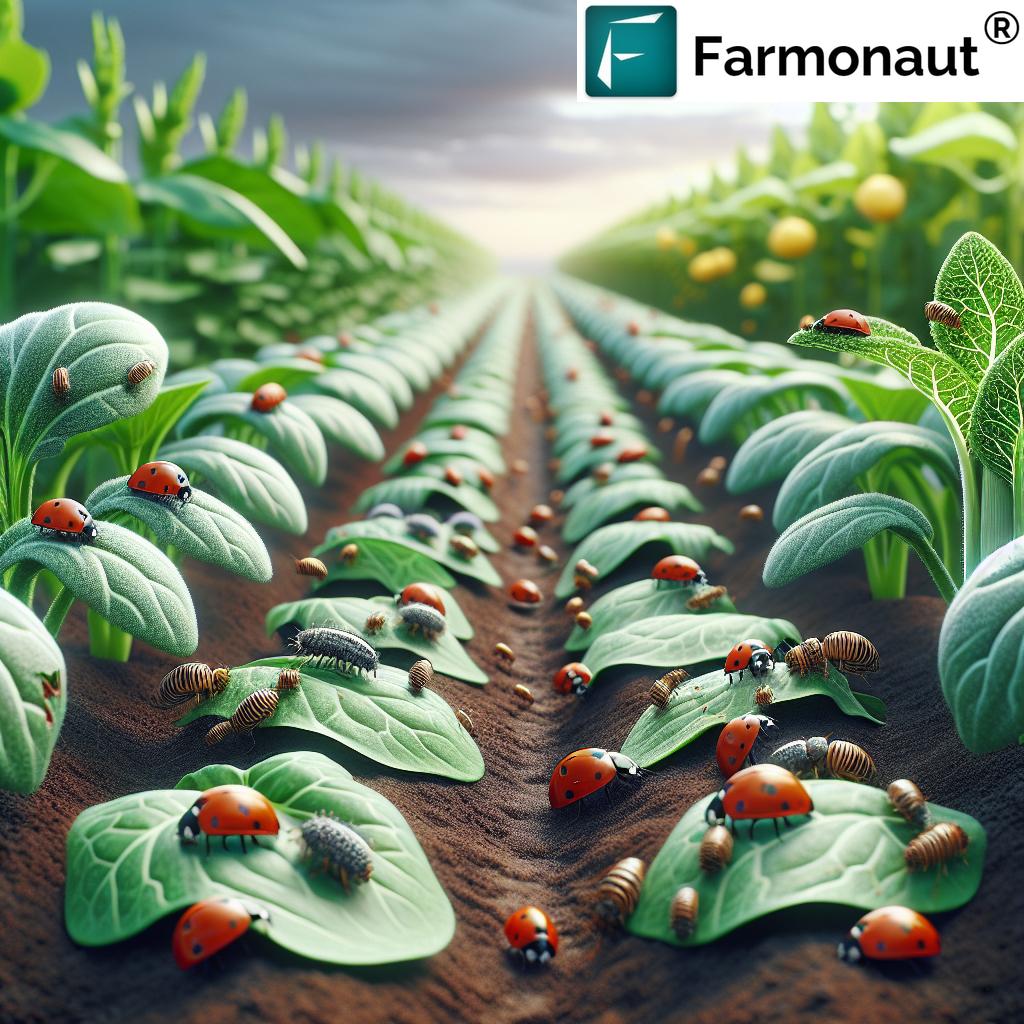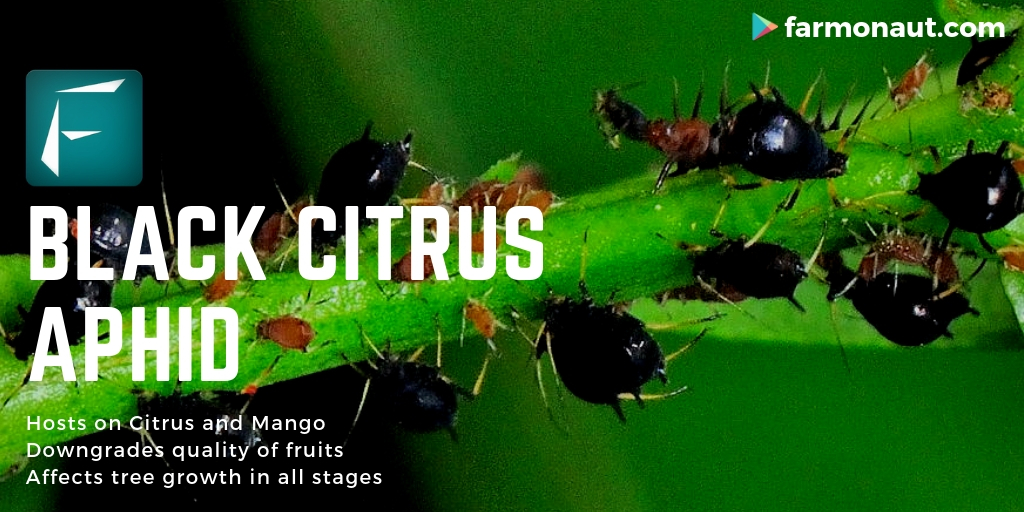Black Bugs on Plants: 7 Powerful Ways to Control Crop Pests
“Up to 40% of global crop losses are caused by pests like black bugs each year.”
- Introduction: Black Bugs on Plants
- Common Types of Black Bugs on Plants
- Understanding Black Bug Damage on Crops and Leaves
- Trivia: Pest Management Benefits
- 7 Powerful Strategies to Control Black Bugs on Plants
- Integrated Pest Management Strategies Comparison Table
- Farmonaut’s Role in Modern Plant Pest Management
- FAQ: Black Bugs and Crop Pests
- Conclusion: Integrated Approach for Crop Protection
Introduction: Black Bugs on Plants
Black bugs on plants are a widespread and challenging threat in agriculture, farming, and forestry across the globe. These dark insects—distinguished by their characteristic coloration—encompass a diverse group of crop pests that can cause significant damage to leaves, stems, and roots of crop and forest plants. Their impact is not limited to rural fields; urban gardens, greenhouses, and even commercial landscapes can suffer from their activity.
Understanding how to identify, monitor, and manage black bugs is crucial for maintaining healthy crops and forests, achieving optimal yields, and reducing crop losses. In this comprehensive guide, we’ll explore:
- Key species of black bugs affecting plants
- How their behavior and feeding habits negatively impact crops
- Integrated pest management strategies to manage and control pest infestations
- How innovative technologies like Farmonaut help enable data-driven, eco-friendly crop protection
Common Types of Black Bugs on Plants
Black bugs on plants are not a single species but a broad category of insects whose dark coloration and destructive appetites make them common black pests in agriculture and forestry. Their biology and behavior vary; some are sap-sucking aphids, others are leaf-notching beetles or stem-piercing bugs. Let’s delve into the most common and damaging types:
1. Black Bean Aphid (Aphis fabae)
The black bean aphid is a small, soft-bodied pest typically black or dark green in color. (Read more)
Where to find: Clustered densely on the undersides of leaves and growing tips on beans, beets, spinach, and many other plants.
Feeding & Impact:
- Aphids feed by sucking plant sap. This leads to distorted shoots, stunted growth, and reduced vigor of the plant.
- Secretes honeydew which promotes sooty mold growth, hindering photosynthesis.
- Potential for virus transmission, further impacting yields.
2. Black Grass Bug (Scotinophora lurida)
The black grass bug, Scotinophora lurida, is a small uniformly black insect about one-quarter inch long, easily identified by its protruding eyes. (Learn more)
Where to find: Especially affecting grasses in pastures and cereal crop fields.
Feeding & Impact:
- Leaves show light-colored spots and feeding injuries.
- Infestations cause significant forage reduction, stunted growth, and reduced yields in crops and pastures.
- Under drought conditions, plants are more stressed and suffer more damage.
3. Black Vine Weevil (Otiorhynchus sulcatus)
The black vine weevil is a matte black, leaf-notching beetle whose larvae are creamy white with a tan-brown head. (Read details)
Where to find: Common among ornamentals, strawberries, rhododendrons in both fields and gardens.
Feeding & Impact:
- Adults feed at night, chewing out distinctive notches along leaf margins.
- Larvae feed on roots and cambium at the base of trunks, potentially leading to root destruction and plant death.
4. Harlequin Cabbage Bug (Murgantia histrionica)
The harlequin cabbage bug features black bodies with vivid red, orange, yellow, and white markings—a true example of warning coloration. (More info)
Where to find: Common pest on cabbage and related crops like broccoli, kale, mustard.
Feeding & Impact:
- Feeds on stems and leaves, causing blotching and tissue death.
- Can carry and transmit pathogens between plants.
- Their bright coloration is both a warning signal to predators and evidence of the toxic plant compounds they sequester from hosts.
5. Black Bugs in Rice (Scotinophora lurida)
In rice farming, Scotinophora lurida is again notorious: (Rice pest info)
Where to find: At the base of rice stems in paddy fields, especially during warm seasons.
Feeding & Impact:
- Feeds on sap at the plant base, causing stunted growth and chlorotic lesions on leaves.
- Results in empty grains and, in severe infestations, causes entire plants to dry out (known as “bug burn“).
Other Black Insects Damaging Crops
Beyond the main five pests, many other small insects with dark coloration (e.g., black leaf beetles, black thrips, dark-colored scale insects) feature similar behaviors that can damage crops through sap-sucking, chewing, or transmitting diseases.
Understanding Black Bug Damage on Crops and Leaves
Signs of Pest Infestation on Leaves and Stems
Recognizing the signs of pest infestation on leaves and other plant parts is the first step in effective plant pest management. Black bugs and their relatives typically cause the following damage:
- Yellowing or mottling on leaves (commonly caused by aphid feeding and virus transmission)
- Sticky honeydew on plant surfaces, followed by sooty mold growth
- Distorted shoots or stunted growth due to sap removal
- Light-colored spots on leaves indicating grass bug damage
- Leaf notches along edges, typical of vine weevil attack
- Empty grains and dry plant bases, signaling severe rice black bug infestation
- Blotching and yellow lesions on cabbage leaves, characteristic of harlequin bugs
- Wilting, premature leaf/fruit drop, or root rot with heavy root-feeder larval activity (e.g., vine weevil)
If you observe any of these, you are likely facing a pest problem involving black bugs on plants. Early detection and correct identification are crucial for effective pest management.
How Black Bugs Cause Damage: Mechanisms and Consequences
Let’s dive deeper into how these black insects damage crops and why the effects can be so devastating:
- Direct Feeding Injuries: Sap-sucking and chewing leads to cell death, distorted growth, loss of photosynthetic area, necrotic spots, and tissue desiccation.
- Indirect Damage: Pest secretions (like aphid honeydew) promote sooty mold growth, which blocks sunlight and reduces photosynthesis.
- Root & Cambium Destruction: Larvae feeding below the soil (e.g., vine weevils) cause hidden but severe root death, sometimes killing the plant quickly.
- Virus & Pathogen Transmission: Aphids and harlequin bugs can transmit viruses and bacteria, with effects far beyond their own feeding injury.
- Yield Reduction: The combined effect is reduced yields of grains, vegetables, fruits, and forage crops due to poor plant growth or even death.
- Pest-Protected Survival: Their dark coloration not only deters some predators but may also allow pests to avoid detection by blending into shadows under leaves or soil.
Common Black Pests in Agriculture: Lifecycle and Seasonality
The lifecycle and seasonal patterns of black bugs affect when and how we should control them. For example:
- Black bean aphid: Rapid reproductive rates in spring and summer demand timely monitoring and intervention.
- Scotinophora lurida: Favored by warm, dry conditions, their affect is worsened by drought.
- Vine weevils: Larvae overwinter in soil, so monitoring begins in late fall/early spring.
- Harlequin bugs: Thrive in warm climates; outbreaks typically coincide with cabbage planting seasons.
Anticipating these patterns is critical for effective, cost-efficient pest control.
Trivia: Pest Management Benefits
“Integrated pest management can reduce black bug infestations by over 60% in treated crop fields.”
7 Powerful Strategies to Control Black Bugs on Plants
How to control black bugs in plants requires an integrated pest management approach—essential to modern, sustainable agriculture. We must combine cultural, mechanical, biological, and chemical practices to effectively reduce pest populations and protect crop yields, all while prioritizing crop and environmental safety.
Here are the 7 most effective strategies for plant pest management:
1. Crop Rotation
- Description: Plant a sequence of unrelated crops to break black bug life cycles and reduce host plant availability.
- Benefits: Reduces overall pest populations, minimizes soil-borne pest build-up, improves soil health.
- Recommended for: Aphids, vine weevils, grass bugs, and other crop-specific pests.
- Example: Rotate between legumes (beans, peas) and cereals (wheat, maize), or between brassicas (cabbage) and solanaceous crops (tomato, eggplant).
2. Timely Planting and Resistant Varieties
- Description: Sow crops at recommended times to avoid peak pest periods; use resistant or tolerant plant varieties.
- Benefits: Minimizes early pest infestation and allows crops to outgrow damage.
- Recommended for: Crops affected by aphids, harlequin bugs, rice black bugs, etc.
- Example: Early or late sowing can help escape grass bug emergence; choosing rice varieties with resistance to Scotinophora lurida.
3. Regular Inspection and Monitoring
- Description: Inspect crops frequently, especially the undersides of leaves and plant bases, using simple tools or advanced tech (e.g., remote sensing with the Farmonaut platform).
- Benefits: Enables early detection of pest outbreaks and targeted interventions, reducing costs and damage.
- Recommended for: All crops where signs of pest infestation on leaves or stems need constant vigilance. Advanced platforms like Farmonaut’s satellite-based crop monitoring tools make this easier (see large scale farm management).
- Example: Weekly field walks combined with NDVI satellite data for early stress signals.
4. Mechanical Control (Handpicking and Trapping)
- Description: Physically remove visible pests by hand; use sticky, pitfall, or light traps to capture adult insects.
- Benefits: Low-cost, chemical-free control for small infestations or in organic settings.
- Recommended for: Vine weevil adults, harlequin bugs, bean aphids, and all visible clusters.
- Example: Crush aphid colonies, collect weevils at night, install yellow sticky traps for winged adults.
5. Biological Control of Plant Pests
- Description: Support and introduce natural predators (ladybirds, lacewings, parasitoid wasps); use biopesticides derived from bacteria, fungi, or botanical extracts.
- Benefits: Provides long-term pest suppression with minimal environmental or crop side effects.
- Recommended for: Aphids (e.g., aphids on plants treatment by ladybugs), soft-bodied bugs, and in IPM/organic systems. Farmonaut’s traceability platform also helps track application impacts.
- Example: Release of 1500 ladybird larvae/acre, use of neem oil sprays, and Trichoderma-based pathogen suppression for soil pests.
6. Chemical Control of Plant Pests (Insecticidal Soaps and Targeted Pesticides)
- Description: Use insecticidal soaps, horticultural oils, or, as last resort, synthetic pesticides in line with integrated pest management principles.
- Benefits: Rapid knockdown of pest populations if biological, cultural, and mechanical methods are insufficient.
- Recommended for: Severe aphid/AIDS outbreaks, vine weevil larvae, when economic threshold is surpassed.
- Example: Apply insecticidal soap against aphids, or treat rice black bug hotspots with a targeted, label-approved chemical.
Note: Always follow safety intervals, use approved products, and avoid pesticide resistance development. For chemical control of plant pests in large enterprises, consider integrating it with Farmonaut’s API solution for remote monitoring and decision-making, with developer docs at Farmonaut API Docs.
7. Field Hygiene, Sanitation, and Crop Debris Management
- Description: Regularly remove old crop debris, weeds, and plant residues that may harbor pest eggs and larvae.
- Benefits: Reduces overwintering sites for vine weevils, aphids, and harlequin bugs; limits pests’ ability to multiply and return next season.
- Recommended for: All farms and gardens, especially for black bug-prone crops.
- Example: A thorough cleanup after harvest, composting crop residues (if not infested), and removing volunteer plants or wild hosts.
Integrated Pest Management Strategies Comparison Table
Choosing the right combination of control methods is key to effective management of black bugs on plants. Below, we provide a detailed comparison of the main integrated pest management strategies, emphasizing effectiveness, operational costs, and crop safety:
| Control Method | Description | Estimated Effectiveness (%) | Application Frequency | Safety for Crops | Cost Estimate ($/acre) |
|---|---|---|---|---|---|
| Crop Rotation | Seasonally alternating host and non-host crops to suppress pest populations | 60 | Once per crop cycle | High | 10–30 |
| Timely Planting/Resistant Varieties | Planting at optimal times and selecting pest-resistant crop varieties | 50 | Per season | High | Variable (depends on seed) |
| Regular Inspection/Monitoring | Visual scouting and remote monitoring with digital tools (e.g., satellite Apps) | 65 | Weekly/Bi-weekly | High | 5–15 |
| Mechanical Control | Handpicking, trapping, or removing visible pests and infested parts | 40 | As needed | High | 0–15 |
| Biological Control | Release or enhance natural pest enemies; apply biopesticides | 60–75 | Per outbreak/season | High | 30–80 |
| Chemical Control | Targeted application of insecticidal soaps or pesticides | 70–90 | Per outbreak or as needed | Medium | 40–150 |
| Hygiene/Sanitation | Remove, destroy or compost crop debris and weeds post-harvest | 30–40 | Per crop/harvest | High | 5–10 |
Farmonaut’s Role in Modern Plant Pest Management
Modern agricultural challenges demand precision, transparency, and sustainability—especially when it comes to pest management. This is where advanced solutions like Farmonaut redefine crop and field protection:
- Satellite-Based Crop Health Monitoring: Farmonaut’s NDVI (Normalized Difference Vegetation Index) and multispectral satellite imagery instantly highlight crop stress, allowing us to detect areas affected by black bugs before severe damage occurs. This proactive monitoring is available via the Farmonaut App (Try Now).
- Real-Time AI-Driven Advisory (Jeevn AI): Get personalized pest alerts and treatment recommendations based on continuous satellite data and weather inputs, improving the timeliness and effectiveness of interventions.
- Flexibility and Accessibility: Whether you manage a single farm, a plantation, or an agro-enterprise, Farmonaut offers solutions through both crop & plantation management tools and scalable API integration for developers. For detailed custom integration, visit the Developer Docs.
- Traceability & Transparency: As pest outbreaks threaten product integrity, Farmonaut’s blockchain-based traceability solution keeps every agricultural transaction and treatment secure, transparent, and verifiable.
- Resource Management: Optimize fleet management and field operations using Farmonaut’s logistics platform, reducing labor costs and improving application timing during pest outbreaks (Fleet Management Features).
- Sustainability: With carbon footprinting analytics, farmers can analyze environmental impact, meet regulatory standards, and adopt more eco-friendly pest management practices.
- Access to Financing: Secure crop loans and insurance faster with satellite-based field verification, facilitating sustainable farming investments.
FAQ: Black Bugs and Crop Pests
What are the most common black bugs on plants in agriculture?
The most common include black bean aphid (Aphis fabae), black grass bug (Scotinophora lurida), black vine weevil (Otiorhynchus sulcatus), and harlequin cabbage bug (Murgantia histrionica), as well as various dark thrips and scale insects.
How can I tell if black bugs are damaging my crops?
Look for signs like yellow/mottled spots on leaves, sticky honeydew and sooty mold, distorted shoots, stunted growth, or notched leaf edges. Root-feeding causes wilting, poor yield, or sudden plant death.
Are chemical pesticides always needed for black bug control?
No—integrated pest management favors cultural, mechanical, and especially biological controls first. Chemical control is only for severe or unmanageable outbreaks.
What is the safest way to reduce black bug infestations?
Use a mix of crop rotation, monitoring, mechanical removal, and natural predator support. Keep fields clean and intervene early for best results.
How can technology help manage black bugs on plants?
Technology platforms like Farmonaut offer real-time, remote crop health monitoring, pest mapping, and AI-driven recommendations to spot outbreaks early and manage them efficiently and sustainably.
Should I use the Farmonaut App or API for pest management?
Individual farmers and small producers benefit from the mobile/web App. Developers and large agribusinesses may prefer the API for custom solutions.
Conclusion: Integrated Approach for Crop Protection
Black bugs on plants are a constant menace in agriculture, farming, and forestry, causing significant losses to crop yields and plant health. The dark coloration these pests share is a reminder of their resilience and the challenges they present. But, with informed plant pest management—from cultural and mechanical methods to biological and judicious chemical interventions—we can protect our crops and our livelihoods while conserving the environment.
The critical takeaway: Integrated pest management is not a single action, but an ongoing process of monitoring, prevention, and targeted response. Utilizing smart platforms like Farmonaut empowers us to detect signs of pest infestation on leaves early, take data-driven decisions, and ensure the highest possible yields with the lowest possible risk.
By staying vigilant, employing effective strategies, and embracing technology, we can face down black bugs on plants and secure a sustainable, productive, and resilient agricultural future.
Protect your fields, increase your yields, and take control of pests—
try Farmonaut’s crop health and pest management platform here today!

















